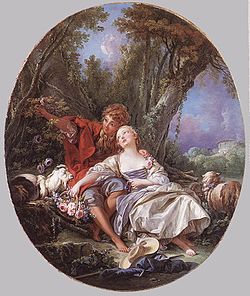| Bastien und Bastienne | |
|---|---|
| one-act singspiel by W. A. Mozart | |
 Shepherd and Shepherdess Reposing (1761), by François Boucher | |
| Librettist |
|
| Language | German |
| Based on | Les Amours de Bastien et Bastienne by Justine Favart and Harny de Guerville |
Bastien und Bastienne (Bastien and Bastienne), K. 50 (revised in 1964 to K. 46b) is a one-act singspiel, a comic opera, by Wolfgang Amadeus Mozart.
Contents
Bastien und Bastienne was one of Mozart's earliest operas, written in 1768 when he was only twelve years old. It was allegedly commissioned by Viennese physician and 'magnetist' Dr. Franz Mesmer (who himself would later be parodied in Così fan tutte ) as a satire of the 'pastoral' genre then prevalent, and specifically as a parody of the opera Le devin du village by Jean-Jacques Rousseau. [1] The German libretto is by Friedrich Wilhelm Weiskern, Johann Heinrich Friedrich Müller and Johann Andreas Schachtner, based on Les Amours de Bastien et Bastienne by Justine Favart and Harny de Guerville. After its supposed premiere in Mesmer's garden theater (that is only corroborated by an unverified account of Nissen), it was not revived again until 1890. It is not clear whether this piece was performed in Mozart's lifetime. The first known performance was on 2 October 1890 at Architektenhaus in Berlin. [2] [3]
The opera is written in both the French and German manners. Many of the melodies are French in manner, but Bastienne's first aria is a true German lied. This melody is also used in Mozart's Trio in G for Piano, Violin and Violoncello, K. 564 (1788). Another purely German lied is Bastienne's aria "I feel certain of his heart". [1] Mozart utilizes the orchestra sparingly, with the exception of the reconciliation scene. [1]
The opening theme of Mozart's overture resembles that of the first movement of Beethoven's Symphony no. 3, Eroica (in a different key). It is unlikely that Beethoven was familiar with Mozart's youthful opera. In any case, opening a movement with an arpeggio of the tonic chord was an extremely common occurrence in the Classical period. The resemblance is likely coincidental.
Although he was very young, Mozart already had excellent vocal writing skills and a knack for parody and whimsy which would reach full flower in his later works. Bastien und Bastienne is possibly the easiest to perform of Mozart's juvenile works.